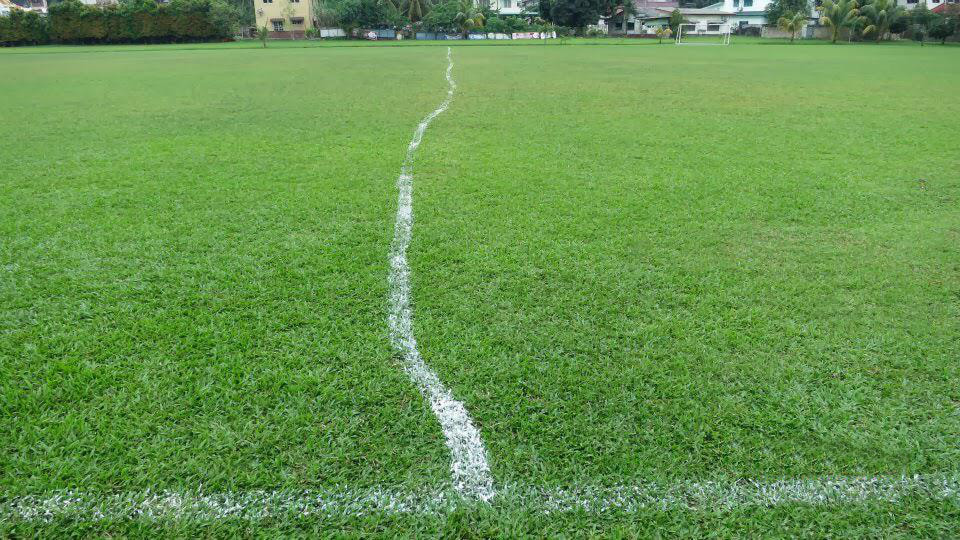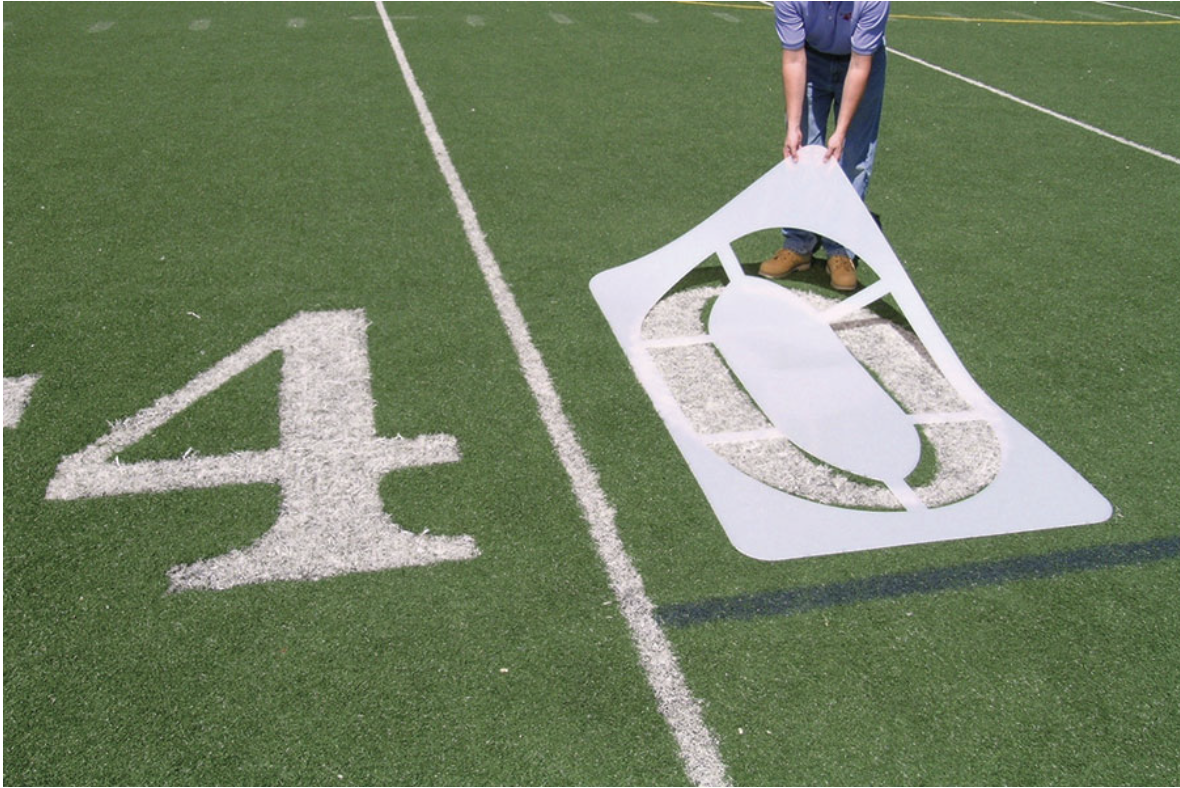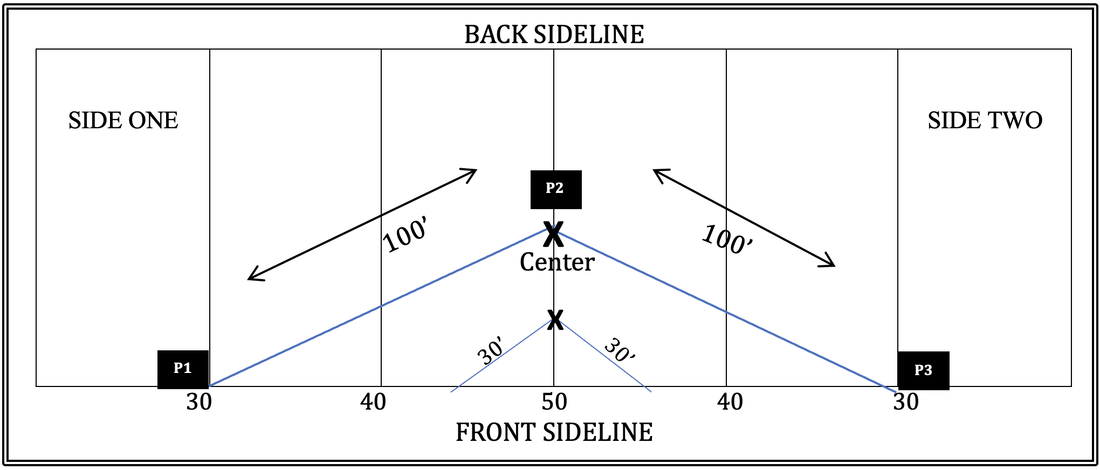Introduction
You’ve just secured a great high school teaching job, and are now officially a band director. You set up your band camp schedules, you assign instruments, you buy all the music, and your drill designer has sent you the opener drill. You are ready for greatness! Until you step outside to the rehearsal field and realise that no one has bothered to line it over the summer months, and you’re staring at a big empty field of green grass. What do you do now?
Don’t fret. After familiarizing yourself with this guide, you will never be without the knowledge of how to line a field – any field – for use by your marching band, and your field will never look like this:
"Oops"
Tools of the Trade
Note: It is possible to purchase field lining “kits” from band-specific retailers (such as Bandshoppe) for anywhere between $300 and $600. While these are certainly handy, they are not absolutely necessary, as long as you have the tools listed above and at least three people to help. Directions
Please read these directions carefully before you begin to set the field markings. It is not an easy thing to “erase” a poorly-marked field and start over!
1. Pre-Marking Decisions. Decide how much “field” you need. It makes little sense for a marching band of 40 members to line an entire 120 yards of football field (100 yards plus the two end zones) if the drill is only set inside the 30-yard lines. Obviously, larger bands may need a full-sized field, and medium-sized bands may need a slightly smaller field, etc. 2. Set the Front Sideline. As mentioned above, this can be up to 360 feet if you are painting a full field plus end zones (100-yard field, two 10-yard endzones / 120 yards x 3 feet = 360 feet). If, for example, you only need enough field to accommodate a show that stays between the 25-yard lines, you’d set a 150-foot sideline (25-yard line to 25-yard line = 50 yards, 50 x 3 feet = 150 feet). Set the line with your tape measure and marking rope running alongside it. Make sure to pull the rope taut! Remove the measuring tape, leave the rope in place, and paint the Front Sideline. 3. Set the front yard line “ticks.” Decide where the 50-yard line is going to be, and place a large perpendicular “tick” for it at the Front Sideline. Then set out sideways from the 50-yard line tick and place small ticks for the other yard lines, every 5 yards (15 feet). If you use End Zones, don’t forget that they are 10 yards wide (i.e., 30 feet). This process needs to be incredibly accurate in order to get the field dimensions correct, so please measure your yard line distances carefully! 4. Set Center Field. Welcome to the magic of triangulation! This step is best accomplished with a field-lining accomplice (or two). Measure out 200’ of the tape measure, with one person (p1) holding the 0’ mark, another person (p2) holding the 100’ mark, and a third person (p3) holding the 200’ mark. Have (p1) go to the Side One 30-yard line tick on the Front Sideline, have (p3) go to the Side Two 30-yard line tick on the Front Sideline, and finally, (p2) should pull the two 100’ lengths tight out onto the field. This should be 80’ from the sideline, and marked as the center (many like to use a big orange or red “X” here, though white paint is perfectly acceptable as well).
Setting Center Field
5. Set the 50-yard line. Measure 160’ from the front sideline, making sure to cross all of your points in a straight line, and mark where the back sideline should be. Set down the marking rope and paint the 50-yard line. During this process, you should paint tick marks for your front and back hashes. Hash marks are placed in different areas of the field depending on whether the field is used for high school, college, or NFL (and let’s not even get started with Canadian football fields).
Pro Tip: It might be handy to have a pre-measured length of marking rope (separate from the main marking rope) or thin chain to use for quickly setting the hash marks.
6. Set the End lines. This step obviously only applies to marching bands that require a full field. Measure out 200’ of the tape measure, with (p1) holding the 20’ mark, (p2) holding the 100’ mark, and (p3) holding the 200’ mark. Keeping in mind that an End Zone is 10 yards/30 feet long, have (p1) stand on the Front Sideline at the back of the End Zone (in other words, 10 yards/30 feet past the Goal Line tick).
7. Have (p3) stand at the 10-yard line tick on the Front Sideline, and have (p2) pull the line taut, much in the same way as was done for the 50-yard line. (p3) should line up with the center mark. Put a mark in this spot (make sure the rope is taut!). Now paint the Side One End Line (160’ from front sideline to back sideline). During this process, you should also paint tick marks for your front and back hashes, to be painted once the yard lines and back sideline are finished. Repeat this process for the Side Two End Line.
Setting End Zones
8. Set the Back Sideline. At this point, you should have two End Line ticks, as well as the 50-yard line tick on the Back Sideline and should be able to pain the Back Sideline by intersecting your guide rope from End Line to End Line through the 50-yard line tick. Put down tick marks every five yards/15 feet for each yard line
9. Set your remaining yard lines. Connect the tick marks on the front sideline to the back sideline and paint your yard lines. Always make sure your guide rope is taut! 10. Set your Hash Marks. You can similarly now run your guide rope from end zone to end zone through the hash mark ticks and paint your front and back hash marks. NCAA and High School Regulations
The following regulations govern the lining of football fields at the HS and college levels, and should be kept in mind:
The following videos may be useful in helping to understand field lining: Miscellany
Got any tips that can help make field lining even easier? Any corrections or elaborations on anything above? Feel free to leave a comment!
And as always, if you are in need of marching band drill design or music arrangements, check out the linked pages for the services I offer. |
MeMusician. Educator. Conductor. Archives
April 2025
Categories |








 RSS Feed
RSS Feed